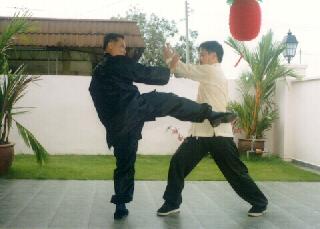STRATEGIES FOUND IN TAIJIQUAN AND SHAOLIN COMBAT SEQUENCES

The strategy in this Taijiquan combat sequence is "Across Beach Watch Fire"
Question 4
Are any of the 36 Strategies found in our 12 Wahnam Taijiquan or 16 Shaolinquan combat sequences?
Sifu Kevin Barry
Answer
Historically the 12 Wahnam Taijiquan and the 16 Shaolin Kungfu combat sequences are not composed with the 36 Strategies in mind. Their composition was based on certain themes which include combat tactics and strategies.
The meaning of “strategy” in combat strategies and the 36 Strategies is quite different. A combat strategy refers to guidelines for general action, whereas guidelines for specific action for the combat situation in question are referred to as tactics. In the 36 Strategies, a strategy is a trick.
For example, avoiding an opponent’s strength and attacking his weakness is a strategy. When we hit grass to startle a snake is to trick it to come out so that we can catch it.
When we meet a particular opponent who is good at kicks but has poor balance after kicking, we use the tactic of avoiding his kicks and moving in immediately after his kicks to fell him. This tactic is based on the general strategy of avoiding an opponent’s strength and attacking his weakness.
In a different situation, a Boxer is very fast in his punches, but he is untrained in taking kicks. The former is his strength and the latter is his weakness. We use the same strategy of avoiding an opponent’s strength and attacking his weakness. But the tactic in this case is different.
When he punches, instead of warding of his punches, we move back to avoid them. When he hesitates, we move in to kick him, instead of striking him. This is a tactic, and for convenience we may call it “retreat and kick”.
If we use our brain besides our brawn, instead of sacrificing our brawn in free exchange of blows as many martial artists do today, we discover that we need not have to move our feet to avoid his punches, we just shift back our body. We also discover that we can shift back our body and kick him at the same time.
Nevertheless, it may be fun trying to see if any of the 36 strategies are found in the Taijiquan and the Shaolin combat sequences, focusing on the initiator’s mode. Keep in mind the examples below is just one way of looking at the combat sequences with reference to the 36 strategies, there can be other ways.
12 Taijiquan Combat Sequences
- The first Taijiquan combat sequence uses “Turn Guest Become Host”, defending an opponent’s attack, then attacking him
- The strategy used in the second combat sequence is “Sound East Strike West”.
- This is “Continuous Strategy”.
- This is “Close Door Catch Thief”.
- Here the strategy is “Use Rest to Wait for Labour”, striking an opponent as he attacks.
- The pattern “Striking Tiger Poise” manifests the strategy “Across Beach Watch Fire”.
- The strategy here is “Troubled Water Catch Fish”, confusing an opponent with hand attacks, then kicking him unexpectedly.
- This strategy is “Across Beach Watch Fire”.
- This is an interesting application of the strategy “Turn Guest Become Host”, but used differently from that in Sequence 1. Here, when an opponent thinks he has felled you, he finds himself felled instead!
- This is “Snatch Goat Along Way”, striking an opponent following his momentum.
- This is “Troubled Water Catch Fish”, confusing an opponent, then striking him.
- The strategy used is “Beneath Cauldron Withdraw Firewood”.
16 Shaolin Combat Sequences
- The strategy in the first combat sequence is “Turn Guest Become Host”, first defending an opponent’s attack, then attacking him.
- The strategy in the second combat sequence is also “Turn Guest Become Host”.
- The trick is to feint a top attack, but the real attack is below, using the strategy “Sound East Strike West”.
- The “Continuous Strategy” is used here.
- The “Continuous Strategy” is also used here.
- The trick is to tempt an opponent to attack with a punch so that you can strike his ribs, using the strategy “Throw Stone Attract Jade”.
- The strategy “Troubled Water Catch Fish” is used here, causing confusion with a low punch, then chopping an opponent’s head.
- The strategy used here is “Snatch Goat along Way”. After striking an opponent’s arm, while he is still startled, strike his neck.
- Here the strategy “Use Rest to Wait for Labour” is used. Let an opponent move in to attack, then kick him.
- Here is the “Continuous Strategy”, pressing on an opponent.
- This is “Sound East Strike West”, often used in combat.
- This is “Beneath Cauldron Withdraw Firewood”, closing an opponent, apparently giving him no chance to defend, and kicking him.
- This is also “Beneath Cauldron Withdraw Firewood” but used in a very different way, apparently giving an opponent no chance to escape.
- This is “Snatch Goat Along Way”.
- Here is “Ascend Roof Remove Ladder”’.
- This is “Golden Cicada Sheds Shell”, escaping from an opponent’s attack, and countering from a side.
The 36 Strategies originated from warfare. Using the 36 Strategies in combat sequences reminds us of Sun Tzu’s advice that whatever that could be used in mass warfare could be used in personal combat, including non-physical combat in daily life.

The strategy used in this Shaolin combat seque4nce is "Beneath Cauldron Withdraw Firewood"
The question and answer are taken from the thread More Fun! 36 Strategies in the Shaolin Wahnam Institute Discussion Forum.
